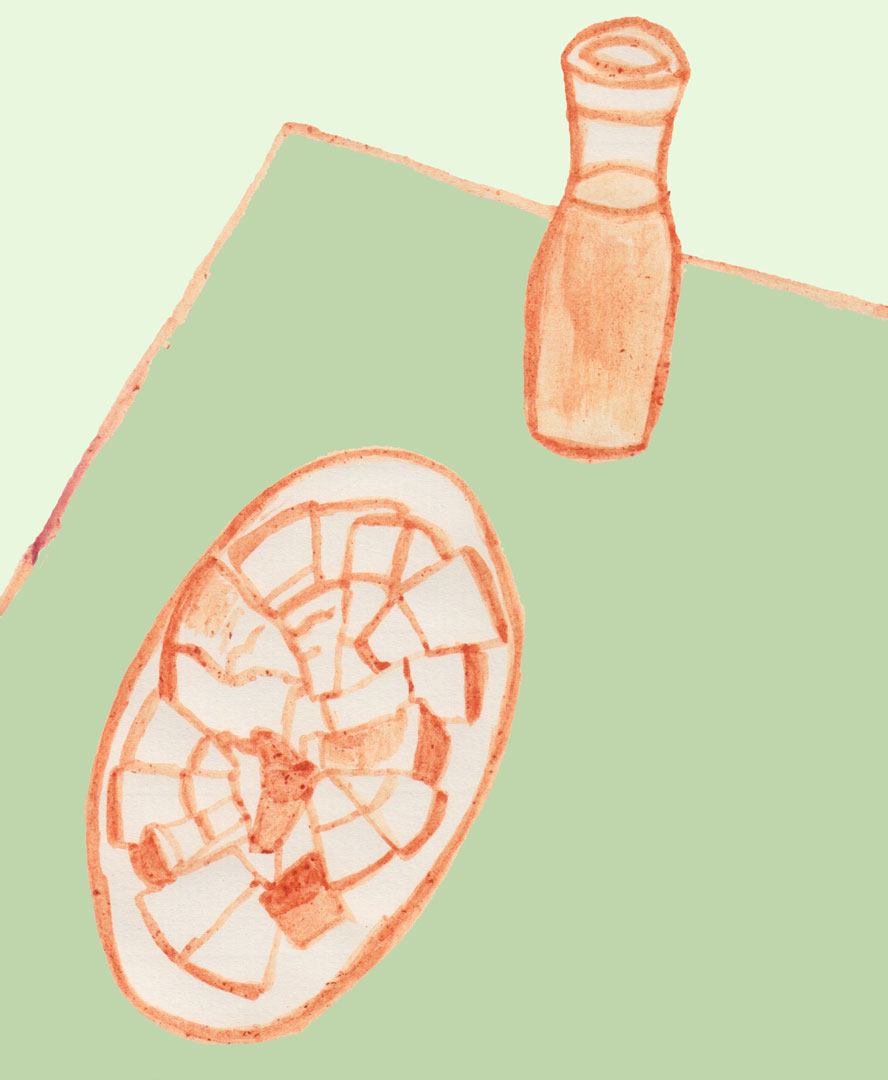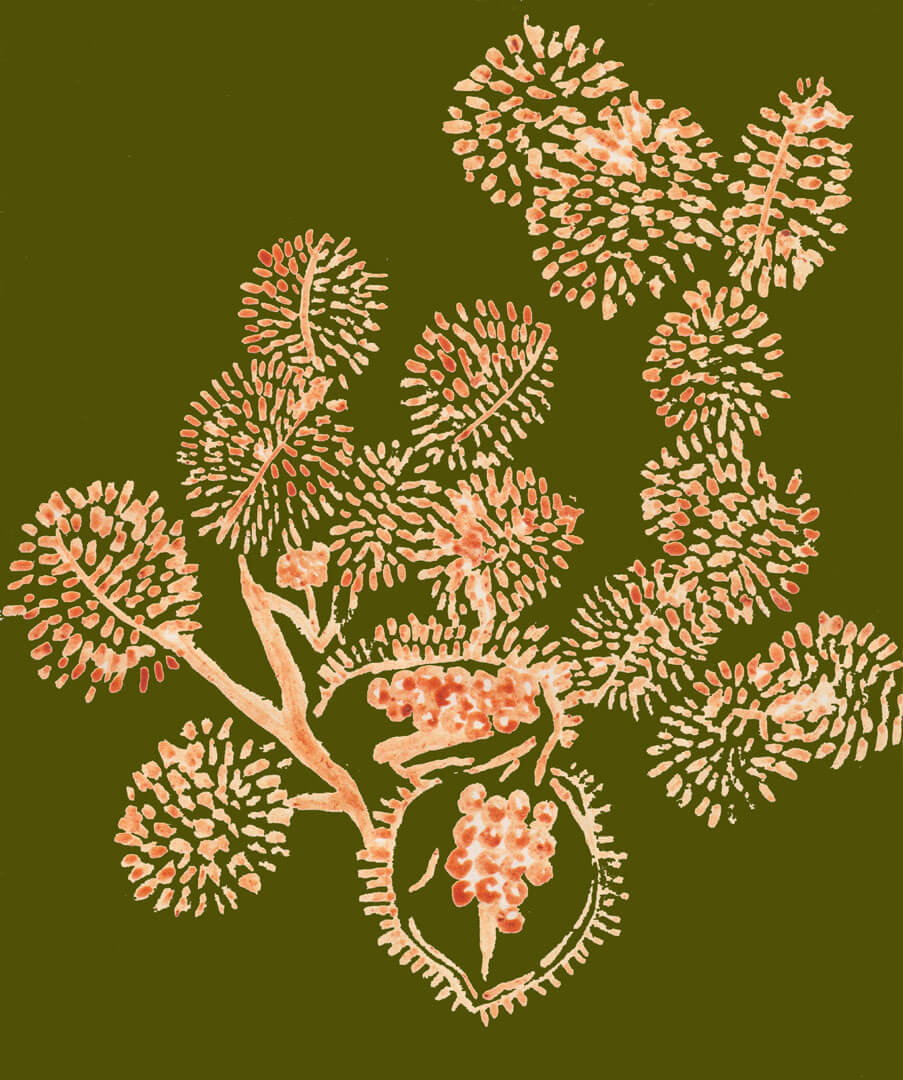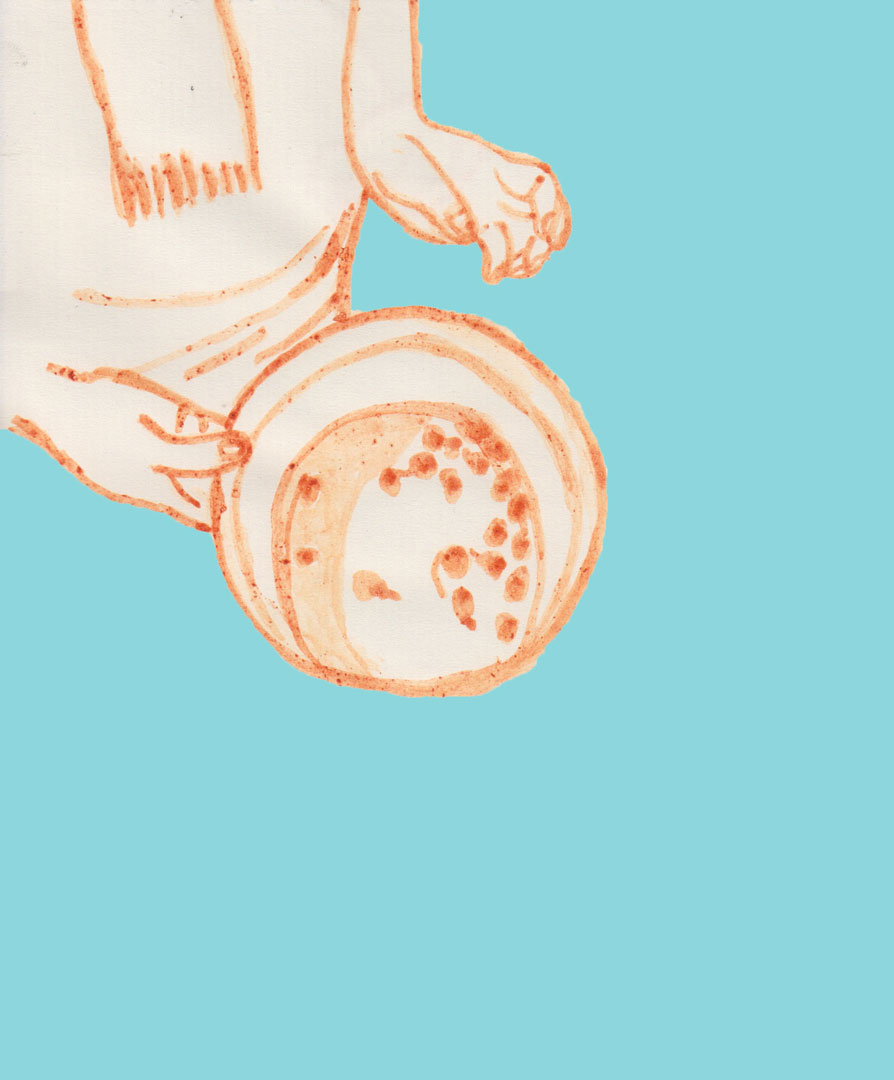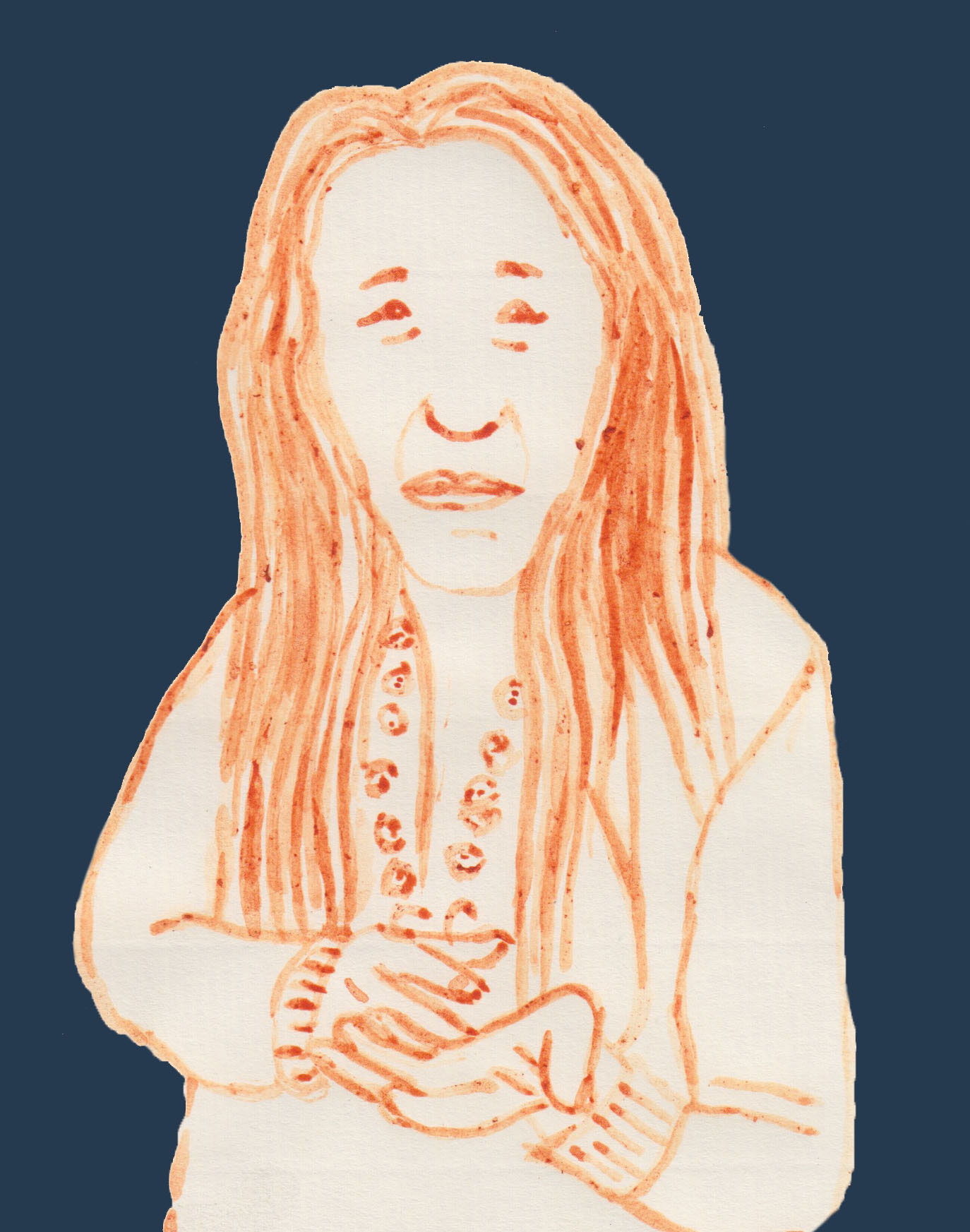Entrance to the building where Niara do Sol lives. Photo by the author
The Dja Guata Porã garden

10:00. Bella and me have an appointment with Niara do Sol. We are waiting at the entrance of the residential complex Zé Kéti, where Niara lives. “You cannot expect Niara to be on time, indigenous people have their own time”, Bella says. What I learned during my stay in Rio de Janeiro is that sensitivity is crucial in first encounters, especially since I am European. As Niara leads us through the housing complex, the greenery becomes lusher and even bushes and trees grow in front of her building. I notice a pair of brown birds sitting on the branches of a tree.
A plaque in the entrance area reads: Associação indígena Aldeia Maracanã. Niara, indigenous daughter of kariri-xokó [1] and fulni-ô [2] parents, lives here with other indigenous people who were evicted from the Aldeia Maracanã in 2013. Together they formed the Aldeia Vertical, a space of cohabitation and relation in a building of the Minha Casa Minha Vida program [3]. Together with two friends of the same building, Iracema Pankaruru and Dauá Puri, Niara participated in the 2017 Dja Guata Porã [4] exhibition at the Museu de Arte do Rio (MAR). She led the Estação Natureza (Nature Station), a vegetable garden in front of the museum. When the exhibition closed, she took the plants and continued the garden on the grounds that extend around the Aldeia Vertical building to the wall of a former prison.
Niara invites us to enter her apartment. We sit down and she begins to tell us about her work with the museums of Rio, her family and the use of different plants. On the main table are brown pods. Niara explains: “That’s Pigeon pea, you can make farofa or cook it with beets and carrots, when we have a headache, we take some Pigeon pea and eat it slowly, then we drink Pigeon pea coffee sweetened with black rapadura” [5].

Raw and cooked Pigeon peas. Drawing with achiote color by the author
When I try to write down these details, she tells me that a researcher once came to visit and wrote them down incorrectly. The reason, she says, is that researchers often ask a lot of questions but do not really understand because they do not practice. In the Dja Guata Porã garden, Niara offers learning through multisensory experiences: planting, harvesting, smelling, tasting. Every day, children of the housing complex come by after school to spend time in the Dja Guata Porã garden. Later in the afternoon, Niara serves them a home-cooked lunch. She makes different puddings from turmeric, coffee, beet. At the beginning, the children asked: What is in it? She answered: Smell it, taste it and then try to guess the ingredients. Niara herself learned this way: “My mother is a woman who observes everything, she learned how to paint, she learned how to crochet and make sweets even from France, she never asked, she looked, and when she got home, she practiced. I was raised that way” [6]. I find that it is true for me: After seeing chaya, a Mayan-era plant, for the first time and tasting its juice at Niara’s place, I was able to identify it in other parts of Rio city.
Niara likes to work with children because they learn faster and because they can change the adults’ minds: Some children started asking their mothers why they would not give them juices as healthy as Niara’s. As a result, some mothers even started planting in front of their own buildings. This has a great impact in a place where people are used to throwing their garbage in green spaces.

Manioc cake and jenipapo juice. Drawing with achiote color by the author
In the Dja Guata Porã garden visitors meet fruits and herbs in different stages and foods: “Here you can see the tree of jenipapo, you can see the fruit and drink the juice. And the next time you can eat the marmalade and when we want to have a good digestion after lunch, we can drink jenipapo licor” [7]. The plants of Niara are not only nutritious, but often ecologically and medicinally relevant. The already mentioned Pigeon pea is not only a good protein food, but also a nitrogen fixer and can help against various health problems.
The Dja Guata Porã garden is not a normal vegetable garden, but a seedling nursery of mainly unconventional perennial plants: achiote, jenipapo, cotton plant. Visitors regularly ask for seedlings to grow in different parts of Rio and even throughout Brazil. The garden is also not laid out in a conventional way in individual beds. Niara is used to planting everything together, paying attention to the preferences and synergies of the plants. Her garden meets the definition of agroforestry: “the deliberate integration of trees with agricultural crops and/or livestock either simultaneously or sequentially on the same unit of land” (Nair, 1993). When I ask Niara about agroforestry and PANCs [8], she points out that these concepts have only recently been defined. The knowledge she applies is that of her ancestors and has been transmitted and adapted over millennia. This is why Niara’s practice goes far beyond what is academically called “agroforestry” and “sustainable.”
Some plants have deep meaning in her indigenous traditions, such as the red juice of achiote, which is used for body painting: “It can be war, but also a very important commemoration, it depends on the design of the eyes, all of our graphics have meaning, many times the graphics have symbols, so it can be a symbol for healing, a symbol for raising a child, or a symbol to put in the ground if you want to plant” [9].

Achiote plant. Drawing with achiote color by the author
When she plants and harvests, Niara not only connects with other people, but also takes into account the preferences of animals: “The chaya seeds are eaten by birds and I eat the leaves” [10]. When she sows, she waits for good lunar conditions and lets the seedling determine the place of sowing. She takes the time to listen to the “schedules of other life cycles – species, climate, localized interactions – that constitute temporal niches in a particular ecology” (de la Bellacasa, 2017).
Niara also encounters difficulties in her garden. Especially in the dry Brazilian winter, the plants need to be watered, but the apartment complex often suffers from water shortages. Niara is upset that the building has no rain gutters to collect rainwater and use it for the garden. She takes great care to use only a small amount of water for washing dishes and showering, using most of it to water her plants. She also integrates her plants into her daily ecological living practices: “one seed of moringa cleans 500 liters of water, each person can experiment, take a box of very dirty water and put a seed in it. In three days, the water is wonderful and you can consume it” [11].

Moringa seeds in a bowl with dirty water. Drawing with achiote color by the author
Niara had to deal not only with water problems, but also with the bad habits of the residents of the housing complex. At the beginning of the garden, in 2016, people were uprooting the plants. Niara responded by playing a witch who told the people who came to rip something out, “If you put your hand on it, you will freeze to ice.” People started to let go. Niara also strategically planted the more delicate and valuable plants among the more robust ones until they became stronger and could defend themselves.
It becomes clear to me that the Dja Guata Porã garden is not an idyllic place but one marked by productive encounters, but also by conflicts. As Bevilacqua observes: “The efforts also show all the creativity and hardships of an experience that is plural in many ways: indigenous people of different ethnicities living together in a building inside a non-indigenous condominium, and developing a garden whose fruits are destined not only for humans” (Bevilaqua, 2021). Gardens like the one of Dja Guata Porã can teach us to listen to timescales of different groups of ethnicities and species living in urban spaces. It also highlights why pluralistic green spaces are still rare in cities. To really get to know the Dja Guata Porã garden, you have to visit it as often as possible. And as a friend of Niara, you do that one way or another.

Niara do Sol. Drawing with achiote color by the author
Endnotes
- The Kariri-Xocó indigenous people, with around 2,500 people, live on an indigenous land of around 699 hectares in the municipality of Porto Real do Colégio, in the state of Alagoas, on the banks of the São Francisco river (National Museum of Rio de Janeiro & Federal University of Rio de Janeiro (UFRJ), 2018).
- The Fulni-ô form an indigenous group that lives near the Ipanema river, in the municipality of Águas Belas. There is no information about the year in which they were first settled. What is certain is that in the middle of the 18th century they were already known by the name of “Carnijós” (Vasconcelos & Tahyrine, 2022).
- Minha Casa, Minha Vida is a government program that subsidizes low-income people to purchase affordable housing built by private developers. Niara criticizes water leaking into her apartment, but she only pays and receives no benefits.
- Dja guata porã is an expression that in the Guarani language means “to walk well” and “to walk together”. It is also the title of an exhibition that took place at the Museu de Arte do Rio (Rio Museum of Art) between May 2017 and March 2018.
- “Isso é o feijão guandu, você pode fazer farofa ou cozinhá-lo com beterraba e cenoura, quando a gente está com muito dor de cabeça, pega um pouco de feijão guandu e come devagar, depois a gente toma café de feijão guandu adoçado com rapadura preta”.
- “Minha mãe é uma mulher que observa tudo, aprendeu a pintar, aprendeu a fazer crochê e doces até da Francia, nunca preguntou, ela olhou, e quando chegou a casa treinou. Eu fui criada dessa forma”.
- “Aqui vocês viram a árvore de jenipapo, vocês viram a fruta e tomaram o suco. E na próxima vez vocês podem comer a geleia e lá, quando a gente fizer um almoço para ter uma boa digestão, podemos tomar o licor de Jenipapo”.
- Plantas alimentícias não convencionais, known by the acronym PANC, are edible plants that spontaneously appear in Brazil. The biologist Valdely Kinupp has defined this term in 2014. It is increasingly used in academic and popular contexts. Today, more than 10,000 PANCs have been identified.
- “Pintar os olhos tem dois significados: Pode ser guerra, mas também uma comemoração muito importante, depende do desenho dos olhos, todo grafismo da gente tem significado, muitas vezes o grafismo tem símbolos, então pode ser um símbolo de cura, um símbolo para criar uma criança ou um símbolo para colocar na terra se você quiser plantar”.
- “As sementes da chaya são comidas pelos pássaros e eu como as folhas”.
- “Uma semente da moringa limpa 500 litros de água, cada pessoa pode fazer experiência, pegue uma caixa de água muito suja e coloque uma semente. Em três dias a água é maravilhosa e se pode consumir”.
References
- Bevilaqua, C. (2021). Cada apartamento uma oca. Piseagrama, 104–111. https://piseagrama.org/cada-apartamento-uma-oca/
- Biller, D. (2021). Danger or delight? Uphill battle for Brazil’s huge jackfruit. ABC News . https://abcnews.go.com/Lifestyle/wireStory/danger-delight-uphill-battle-brazils-huge-jackfruit-76182430
- Brun, F. G. K., Link, D., & Brun, E. J. (2019). O emprego da arbrização na manutenção da biodiversidade de fauna em áreas urbanas. Revista Da Sociedade Brasileira Arborização Urbana, 2(117). https://doi.org/http://dx.doi.org/10.5380/revsbau.v2i1.66253
- Davis, M., Chew, M., Hobbs, R., Lugo, A., Ewel, J., Vermeij, G., Brown, J., Rosenzweig, M., Gardener, M., Carroll, S., Thompson, K., Pickett, S. T. A., Stromberg, J., del Tredici, P., Suding, K., Ehrenfeld, J., Grime, J., Mascaro, J., & Briggs, J. (2011). Don’t judge species on their origins. Nature, 474, 153–154. https://doi.org/10.1038/474153a
- de la Bellacasa, M. P. (2017). Matters of Care: Speculative Ethics in More than Human Worlds. University of Minnesota Press. http://www.jstor.org/stable/10.5749/j.ctt1mmfspt
- dos Santos, A. R., da Rocha, C. F. D., & Bergallo, H. G. (2010). Native and exotic species in the urban landscape of the city of Rio de Janeiro, Brazil: density, richness, and arboreal deficit. Urban Ecosystems, 13(2), 209–222. https://doi.org/10.1007/s11252-009-0113-z
- Fundação Parques e Jardins. (2015). Plano Diretor de Arborização Urbana de Rio de Janeiro. http://www.rio.rj.gov.br/dlstatic/10112/5560381/4146113/PDAUtotal5.pdf
- Herzog, C. P., & Finotti, R. (2013). Local Assessment of Rio de Janeiro City: Two Case Studies of Urbanization Trends and Ecological Impacts. In T. Elmqvist, M. Fragkias, J. Goodness, B. Güneralp, P. J. Marcotullio, R. I. McDonald, S. Parnell, M. Schewenius, M. Sendstad, K. C. Seto, & C. Wilkinson (Eds.), Urbanization, Biodiversity and Ecosystem Services: Challenges and Opportunities: A Global Assessment (pp. 609–628). Springer Netherlands. https://doi.org/10.1007/978-94-007-7088-1_29
- Nair, P. K. (1993). An Introduction to Agroforestry (International Centre for Research in Agroforestry, Ed.). Springer Dordrecht.
- National Museum of Rio de Janeiro, & Federal University of Rio de Janeiro (UFRJ). (2018). Os primeiros brasileiros. https://osprimeirosbrasileiros.mn.ufrj.br/en/presentation/
- Pedreira, L. O. de L. (2015). The urban forests of Rio de Janeiro City: integrating forests and other land uses for providing environmental and social services.
- Vannozzi Brito, V., & Borelli, S. (2020). Urban food forestry and its role to increase food security: A Brazilian overview and its potentialities. Urban Forestry & Urban Greening, 56, 126835. https://doi.org/https://doi.org/10.1016/j.ufug.2020.126835
- Vasconcelos, J., & Tahyrine, I. (2022). Conheça os Fulni-ô, povo indígena que habita o município de Águas Belas. Brasil de Fato. https://www.brasildefatope.com.br/2022/02/15/conheca-os-fulni-o-povo-indigena-que-habita-o-municipio-de-aguas-belas
- Yeo, S. (2020). Is it time to rethink the language around “non-native” species? Inkcap. https://inkcap.substack.com/p/is-it-time-to-rethink-the-language
- Zenni, R., & Ziller, S. (2012). An overview of invasive plants in Brazil. Brazilian Journal of Botany, 34, 431–446. https://doi.org/10.1590/S0100-84042011000300016
Realização




Produção

